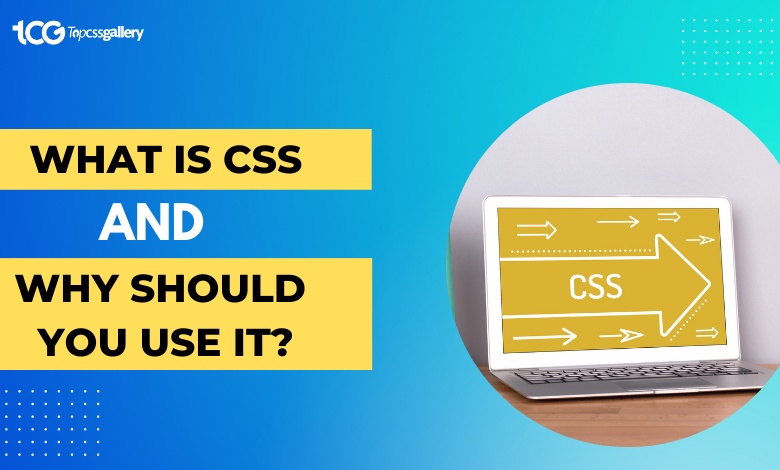You have probably heard of HTML, even if you're not a programmer. CSS is something that you might not be as familiar with. With HTML and JavaScript, CSS is one of the three primary pillars of web technology, making it an equally crucial programming component. However, what exactly is CSS, how does it function, and why is it so important? Let’s continue to read more about CSS.
What is Meant by CSS or Cascading Style Sheets?
CSS is the fastest and super responsive light website-creating technique. Cascading Style Sheets, or CSS, is a coding language used to describe web pages' layout, formatting, and visual appearance. It is a cornerstone technology used in web design and development and is responsible for the visual styling of HTML elements.
CSS works by providing rules for how HTML elements should be displayed. These rules are defined using a set of properties and values that describe the appearance of elements such as font size, color, background, border, and spacing. CSS can be written directly within an HTML file using the style element or saved in a separate file with a .css extension and linked to the HTML document.
Additionally, CSS is an essential tool for web design and development, separating content and presentation and providing the means to create visually engaging and interactive web pages. Its flexibility and versatility make it an invaluable part of the web development process, and its ongoing evolution ensures that it remains a relevant and vital technology for years to come.
What Are the Processes for Working With CSS?
CSS, or Cascading Style Sheets, is a language used to describe the visual appearance of a web page. It provides a set of rules that dictate how HTML elements should be displayed. These rules are defined using a series of properties and values that can be applied to individual elements or groups of elements.
#1: Create a Style Sheet
This can be done in a separate file with a .css extension or directly within the HTML file using the style element. The style sheet contains all of the rules that will be applied to the HTML elements and are linked to the HTML document using the link element.
#2: Defined Styles
Uses selectors to target specific HTML elements to apply the defined styles. Selectors can be based on the element name, class, ID, attribute, or combination. For example, to apply a style to all paragraphs on a page, the selector would be "p", while to apply a style to all elements with a specific class, the selector would be ".classname".
#3: Set of Property
Once a selector has been defined, CSS applies a set of properties to the selected elements. Properties define the visual appearance of the element, such as font size, color, border, padding, and margin. Each property has a value that specifies the exact appearance of the element, such as "12px" for font size or "red" for color.
In the property setting, you need to know about the various properties of CSS. You can ask an experienced web developer about how you can use CSS for building your website. Let’s learn the benefits of using CSS on your website in detail.
Major Benefits of Using CSS in Web Design Process.
CSS, or Cascading Style Sheets, is a crucial component of web development. It is responsible for the visual appearance and styling of HTML elements on a web page. Thus, CSS can play a major role in enhancing your website's performance and function. Here are some key benefits you get after applying CSS to your website.
#1: Separation of Concerns
One of the key benefits of CSS is that it allows for the separation of concerns in web development. HTML is responsible for defining the structure and content of a web page, while CSS is responsible for its visual appearance. This separation means that changes to the visual appearance of a web page can be made independently of the content, making it easier to maintain and update.
#2: Consistency in Design
CSS enables designers to create consistent designs across multiple pages or even entire websites. Using CSS, designers can define styles for different HTML elements, such as headings, paragraphs, and links, and apply these styles consistently throughout the site. This not only improves the visual appeal of the site but also helps to create a more professional and cohesive brand image.
#3: Accessibility
CSS plays an important role in creating accessible web pages. By using CSS to control the layout and presentation of HTML elements, web developers can ensure that their pages are more easily navigable by screen readers and other assistive technologies. For example, CSS can be used to control the order in which elements are read by screen readers, making it easier for visually impaired users to understand the content.
#4: Flexibility
CSS provides a high degree of flexibility in web design. With CSS, designers can create complex layouts, animations, and visual effects that were previously impossible with HTML alone. CSS also makes it possible to use custom fonts, colors, and backgrounds, allowing designers to create truly unique and visually appealing web pages.
#5: Branding
CSS is an important tool for branding a website. By defining consistent styles for different HTML elements, designers can create a visual identity that reflects the brand's personality and values. Consistent use of fonts, colors, and other design elements can reinforce brand recognition and create a lasting impression on visitors.
#6: Compatibility
CSS is compatible with all modern web browsers, making it an ideal tool for web development. This compatibility means that CSS can be used to create websites that are accessible to a wide range of users, regardless of the browser they are using. This ensures that the website is accessible to the maximum number of users, helping to improve user experience and reach a larger audience.
#7: Page Load Time
CSS can significantly improve the load time of a web page. By separating the presentation layer from the content layer, CSS reduces the amount of HTML code that needs to be loaded by the browser. This results in faster load times, which can improve user experience and even boost search engine rankings.
Less use of coding will increase page efficiency and decrease the loading time. The more the loading time, the more the users are frustrated. What actually happens in coding is interesting to know, as how CSS is a savior. Imaging a table field is built-in code; this makes the reading of code twice. First, to understand the table's basic structure, and second, to display the content within the table.
#8: Responsive Design
CSS is essential for creating responsive web designs that adapt to different screen sizes and devices. Using media queries, designers can create layouts that adjust to different screen sizes, ensuring the page is always easy to read and navigate. Currently the mobile users are increasing rapidly. Responsive design is becoming a primary factor for websites.
#9: SEO
CSS can play a role in search engine optimization (SEO) by improving the structure and organization of a website's HTML code. By using CSS to create clean, well-organized code, developers can improve the website's search engine rankings, leading to increased visibility and traffic.
Search engine optimization is critical in today's digital landscape, where businesses are competing for online visibility and attention. Websites that rank higher in search engine results pages (SERPs) are more likely to attract visitors and generate leads, making SEO an essential component of web development.
#10: Maintenance
CSS makes it easier to maintain and update a website. By separating the presentation layer from the content layer, developers can update the appearance of a web page without having to modify the underlying HTML code. This simplifies the maintenance process, making it easier to make changes and updates to the site over time.
These benefits, as mentioned earlier, are just the tip of the iceberg. Apart from these, you can also get many more benefits after working with HTML + CSS for the project. Now, you might be thinking about how you can use CSS for your website; let me share some effective CSS tips with you.
Tips for Using CSS Effectively
Here are the 5 Tips to make your CSS design amazing:
#1: Avoid !important Tag
When your CSS is not working as you were supposed to, applying !important tag can fix your work instantly. Of all CSS selectors, the !important tag has the highest level of specificity.
Using !important tag, you're telling the browser to follow that particular rule always and in every case. This is undesirable because different selectors, including parent and child selectors, may have different CSS rules.
Using another !important tag is the sole technique to override an important tag. This results in the use of increasingly significant tags.
#2: DRY
Don't Repeat Yourself is referred to as DRY. This is a general rule for software development that applies to CSS as well as all other programming languages. DRY seeks to prevent or minimize duplication as much as possible, as its name suggests.
For instance, we could write three CSS classes for three buttons as follows:
.primary-button {
background: blue;
color: white;
border-radius: 5px;
padding: 10px 20px;
text-align: center;
font-size: 16px;
}
.form-button {
background: green;
color: white;
border-radius: 5px;
padding: 10px 20px;
text-align: center;
font-size: 16px;
}
.cancel-button {
background: red;
color: white;
border-radius: 5px;
padding: 10px 20px;
text-align: center;
font-size: 16px;
}
Alternatively, you may apply the DRY principle by writing the unique rules in separate classes and the common rules only once in additional classes:
.button {
color: white;
border-radius: 5px;
padding: 10px 20px;
text-align: center;
font-size: 16px;
}
.primary-button {
background: blue;
}
.form-button {
background: green;
}
.cancel-button {
background: red;
}
As you can see, using the DRY concept prevents repetition, cuts down on the number of lines, and enhances readability as well as performance.
#3: Use Shorthands Code
Certain CSS properties, including paddings, margins, typefaces, and borders, can be written using shorthands in a much more straightforward manner. The number of lines of rules is decreased by using shorthands.
So, without shorthands, a CSS class would seem as follows:
.article-container {
padding-top: 10px;
padding-bottom: 20px;
padding-left: 15px;
padding-right: 15px;
margin-top: 10px;
margin-bottom: 10px;
margin-left: 15px;
margin-right: 15px;
border-width: 1px;
border-style: solid:
border-color: black;
}
And with shorthands codes, it looks like this:
.article-container {
padding: 10px 15px 20px 15px;
margin: 10px 15px;
border: 1px solid black;
}
#4: Use Preprocessor
In larger projects, using a CSS preprocessor like Sass or LESS is particularly helpful. Preprocessors enable us to add CSS code capabilities that are not ordinarily possible.
We can import and export our CSS files into other CSS files, define variables, functions, and mixins, and write nested CSS code, for instance:
nav {
ul {
margin: 0;
padding: 0;
list-style: none;
}
li { display: inline-block; }
a {
display : block;
padding: 6px 12px;
text-decoration: none;
color: black;
&:hover {
cursor: pointer;
color: red;
}
}
}
Because browsers cannot grasp a preprocessor's syntax, it is afterwards converted into ordinary CSS (in a separate CSS file).
#5. Add Comments if Necessary
Generally, the quality codes are already clear and self-descriptive, but in some cases, you need to write additional explanations to explain that later. For example
// Your Comments
.example-class {
// your rules
}
So, if you feel unclear, then you can add comments on some parts of the code but make sure that you are not overdoing it.
End Notes
These are some effective hacks that can bloom your design and website. However, if you are an information seeker, you can visit Best CSS Site, TopCSSGallery. It is the best place to find cool and trending web design and development hacks. Also, you can find so many unique web design inspirations here from top web designers and developers.


No comments yet